CarEdge saved me over 4,500 dollars on a brand new Honda Pilot. I can't say thank you enough.
Price intelligence
Find a wide range of vehicle listings with market insights on new and used listings near you.


Help us personalize your CarEdge experience — it only takes a second.
Your answers help us personalize your CarEdge journey — we’ll follow up with tips and next steps that match your buying timeline.


As electric cars continue to enter the mainstream, the tug-of-war between EV startups and legacy giants is intensifying. With federal EV tax credits now expired, how will EV sales trend? Will Tesla hold its lead, or will Ford, General Motors and the rest catch up? Bookmark this page for the latest quarterly and monthly sales and market share updates for electric vehicles in the United States.
Q3 2025 EV sales numbers reflect the rush to get ahead of the federal tax credit expiration on September 30, 2025:
In the third quarter of 2025, battery electric vehicle market share reached 10.5% of all new car sales in the United States. This is down slightly from 8.9% one year prior, and nearly unchanged from 7.2% of the market in Q2 2025.
Here’s how U.S. EV sales totals in Q3 2025 compare to the past three years:
| Automaker | Q1 2022 | Q2 2022 | Q3 2022 | Q4 2022 | Q1 2023 | Q2 2023 | Q3 2023 | Q4 2023 | Q1 2024 | Q2 2024 | Q3 2024 | Q4 2024 | Q1 2025 | Q2 2025 | Q3 2025 |
|---|---|---|---|---|---|---|---|---|---|---|---|---|---|---|---|
| Tesla (estimate) | 129,743 | 130,047 | 114,000 | 131,574 | 161,630 | 175,262 | 156,621 | 161,375 | 140,187 | 164,264 | 166,923 | 154,900 | 128,100 | 143,535 | 179,525 |
| Ford Motor Company | 6,734 | 15,273 | 18,257 | 20,339 | 10,866 | 14,843 | 20,962 | 25,937 | 20,223 | 23,957 | 23,509 | 30,176 | 22,550 | 16,438 | 30,612 |
| General Motors | 457 | 7,217 | 15,156 | 16,150 | 20,670 | 15,652 | 20,057 | 19,469 | 16,169 | 21,930 | 32,095 | 43,982 | 31,887 | 46,280 | 66,501 |
| Honda Motor Co | 0 | 0 | 0 | 0 | 0 | 0 | 0 | 0 | 0 | 1,873 | 15,291 | 18,838 | 14,374 | 12,278 | 22,236 |
| Nissan | 4,371 | 3,251 | 1,276 | 3,308 | 5,214 | 4,215 | 6,074 | 5,113 | 5,284 | 7,128 | 10,066 | 8,546 | 6,471 | 9,073 | 3,934 |
| Volkswagen Group | 7,932 | 8,961 | 11,893 | 15,193 | 15,723 | 13,977 | 20,295 | 20,403 | 13,806 | 11,904 | 11,900 | 9,755 | 19,827 | 11,043 | 37,400 |
| Hyundai Group (incl. Kia) | 15,480 | 17,979 | 9,796 | 9,641 | 14,346 | 21,696 | 30,757 | 25,447 | 22,936 | 37,044 | 29,609 | 39,649 | 22,995 | 21,493 | 48,650 |
| Subaru | 0 | 0 | 0 | 919 | 1,359 | 1,613 | 2,791 | 3,109 | 1,147 | 4,238 | 3,752 | 3,310 | 3,131 | 3,370 | 3,471 |
| Toyota Motor N.A. | 0 | 0 | 240 | 985 | 1,840 | 2,893 | 4,221 | 5,718 | 3,500 | 11,607 | 6,851 | 6,309 | 7,064 | 5,964 | 5,032 |
| Mercedes-Benz | 2,091 | 1,959 | 2,717 | 5,656 | 5,053 | 9,029 | 10,423 | 10,767 | 12,250 | 9,270 | 9,447 | 3,763 | 3,472 | 4,611 | 5,973 |
| Mazda | 0 | 0 | 0 | 324 | 15 | 51 | 34 | 0 | 0 | 0 | 0 | 0 | 0 | 0 | 0 |
| BMW Group | 1,171 | 1,082 | 4,337 | 7,099 | 6,585 | 11,990 | 13,594 | 15,364 | 11,455 | 14,081 | 13,028 | 13,876 | 14,234 | 11,094 | 10,950 |
| Jaguar | 0 | 114 | 0 | 298 | 8 | 80 | 86 | 78 | 256 | 1,188 | 779 | 763 | 381 | N/A | N/A |
| Stellantis | 0 | 0 | 0 | 0 | 0 | 0 | 0 | 0 | 0 | 204 | 235 | 531 | 4,990 | 2,352 | 6,939 |
| Volvo-Polestar | 3,092 | 4,518 | 3,510 | 5,616 | 5,228 | 7,608 | 7,797 | 6,531 | 3,279 | 2,285 | 3,913 | 3,028 | 2,718 | 2,898 | 3,058 |
| Rivian | 1,227 | 4,467 | 6,584 | 8,054 | 7,946 | 12,640 | 15,564 | 13,553 | 13,588 | 13,790 | 10,018 | 8,503 | 8,640 | 10,599 | 13,201 |
| Lucid | 460 | 482 | 1,398 | 1,060 | 1,368 | 1,659 | 1,618 | 1,512 | 1,967 | 1,855 | 2,781 | 3,099 | 2,400 | 2,635 | 4,078 |
| Vinfast | - | - | - | - | 110 | 740 | 1,159 | 1,120 | 927 | 1,225 | N/A | 1,800 | 525 | N/A | N/A |
| Additional EV Models | - | - | - | - | - | - | - | - | - | - | - | - | 5,930 | 3,508 | 2,288 |
| TOTAL US EV sales | 173,561 | 196,788 | 188,924 | 226,789 | 258,882 | 295,355 | 313,086 | 317,168 | 268,909 | 330,463 | 346,309 | 348,879 | 296,227 | 310,839 | 437,487 |
Data source: Cox Automotive
Data for Q3 2025 will be available as automaker sales totals are finalized in October.
| Automaker | Q1 2022 | Q2 2022 | Q3 2022 | Q4 2022 | Q1 2023 | Q2 2023 | Q3 2023 | Q4 2023 | Q1 2024 | Q2 2024 | Q3 2024 | Q4 2024 | Q1 2025 | Q2 2025 | Q3 2025 |
|---|---|---|---|---|---|---|---|---|---|---|---|---|---|---|---|
| Tesla | 74.8 | 66.1 | 60.3 | 58.0 | 62.4 | 59.3 | 50.0 | 50.9 | 52.1 | 49.7 | 48.2 | 44.4 | 43.5 | 46.2 | 40.9 |
| Ford | 4.4 | 7.8 | 9.7 | 9.0 | 4.2 | 5.0 | 6.7 | 8.2 | 7.5 | 7.2 | 8.6 | 8.7 | 7.7 | 5.3 | 7.0 |
| General Motors | 0.3 | 3.7 | 8.0 | 7.2 | 8.0 | 5.3 | 6.1 | 6.1 | 6.0 | 6.6 | 9.3 | 12.6 | 10.8 | 14.9 | 15.2 |
| Honda Motor Co | 0.0 | 0.0 | 0.0 | 0.0 | 0.0 | 0.0 | 0.0 | 0.0 | 0.0 | 0.5 | 4.4 | 5.4 | 4.8 | 4.0 | 5.1 |
| Nissan | 2.5 | 1.7 | 0.7 | 1.5 | 2.0 | 1.4 | 1.9 | 1.6 | 2.0 | 2.2 | 2.9 | 2.5 | 2.2 | 2.9 | 1.0 |
| Volkswagen Group | 4.6 | 4.6 | 6.3 | 6.7 | 6.1 | 4.8 | 6.5 | 6.4 | 5.1 | 3.6 | 3.4 | 2.8 | 6.7 | 3.6 | 8.5 |
| Hyundai Motor Group (incl. Kia) | 8.9 | 9.1 | 5.2 | 4.3 | 5.6 | 7.3 | 9.9 | 8.0 | 8.5 | 11.2 | 6.8 | 11.4 | 7.8 | 6.9 | 11.1 |
| Mercedes-Benz | 1.2 | 1.0 | 1.4 | 2.5 | 2.0 | 3.1 | 3.3 | 3.4 | 4.6 | 2.8 | 2.7 | 1.2 | 1.2 | 1.5 | 1.4 |
| Mazda | 0.1 | 0.1 | 0.0 | 0.0 | 0.0 | 0.0 | 0.0 | 0.0 | 0.0 | 0.0 | 0.0 | 0.0 | 0.0 | 0.0 | 0.0 |
| Toyota Motor N.A. | 0.0 | 0.0 | 0.0 | 0.4 | 0.7 | 1.0 | 1.3 | 1.8 | 1.3 | 3.5 | 2.0 | 1.8 | 2.4 | 1.9 | 1.1 |
| Subaru | 0.0 | 0.0 | 0.0 | 0.4 | 0.5 | 0.5 | 0.9 | 1.0 | 0.4 | 1.3 | 1.1 | 1.0 | 1.1 | 1.1 | 0.8 |
| BMW | 0.7 | 0.5 | 2.3 | 3.1 | 2.5 | 3.9 | 4.2 | 4.8 | 4.3 | 4.3 | 3.8 | 4.0 | 4.8 | 3.6 | 2.5 |
| Stellantis | 0.0 | 0.0 | 0.0 | 0.0 | 0.0 | 0.0 | 0.0 | 0.0 | 0.0 | 0.0 | 0.0 | 0.1 | 1.7 | 0.8 | 1.6 |
| Jaguar | 0.1 | 0.1 | 0.0 | 0.0 | 0.0 | 0.0 | 0.0 | 0.0 | 0.0 | 0.4 | 0.2 | 0.2 | 0.1 | 0.0 | 0.0 |
| Rivian | 0.7 | 2.3 | 3.5 | 3.1 | 3.1 | 4.3 | 5.0 | 4.3 | 5.1 | 4.2 | 2.9 | 2.4 | 2.9 | 3.4 | 3.0 |
| Lucid | 0.3 | 0.2 | 0.7 | 0.5 | 0.5 | 0.6 | 0.5 | 0.5 | 0.7 | 0.6 | 0.8 | 0.9 | 0.8 | 0.8 | 0.9 |
| Vinfast | 0.0 | 0.0 | 0.0 | 0.0 | 0.0 | 0.3 | 0.4 | 0.4 | 0.3 | 0.3 | 0.0 | 0.5 | 0.1 | 0.1 | 0.0 |
| Volvo/Polestar | 1.9 | 2.3 | 1.9 | 1.6 | 2.0 | 2.6 | 2.5 | 2.1 | 1.2 | 0.7 | 1.1 | 0.9 | 1.0 | 0.9 | 0.7 |
| Other EV Sales | - | - | - | - | - | - | - | - | - | - | - | - | 2.0 | 2.0 | 0.5 |
Data source: Cox Automotive
In Q3 2025, Tesla was down to 41% of EV market share in America. Tesla remains the dominant player in an increasingly crowded field, even with falling market share. According to analyses by Cox Automotive, Tesla sales accounted for 49% of all EVs sold in the US in 2024, down from 55% in 2023, and 62% in 2022. At the start of 2022, Tesla had a 75% EV market share in America.
Ford, GM, and Hyundai Motor Group continue to fight for second place. Hyundai and Kia EV sales soared in 2024, but have waned this year. Last year, Ford’s EV sales were overtaken by GM somewhat unexpectedly. GM is now running away from Ford, outselling their chief rival nearly three to one.
| Q1 2023 | Q2 2023 | Q3 2023 | Q4 2023 | Q1 2024 | Q2 2024 | Q3 2024 | Q4 2024 | Q1 2025 | Q2 2025 | |
| Battery Electric Vehicles (BEV) | 7.3% | 7.2% | 7.9% | 8.1% | 7.3% | 8.0% | 8.9% | 8.7% | 7.5% | 7.4% |
| Electrified (HEV, PHEV, BEV) | 14.5% | 16.0% | 17.7% | 16.0% | 17.8% | 19.1% | 21.2% | 30.7% | TBD | TBD |
In 2024, the US EV market share reached 8.1% of all light vehicle sales, up from 7.3% of sales in 2023. In 2022, 5.8% of the new cars Americans bought were fully electric, which was a sharp increase from 3.2% in 2021.
According to EIA.gov, Combined sales of hybrid vehicles, plug-in hybrids, and battery electric vehicles in the United States rose to 16.3% of total new light-duty vehicle sales in 2023. In 2022, hybrid, plug-in hybrid, and BEV sales were 12.9% of total sales.

Electrified powertrains continue to see rapid growth, despite less growth in the electric-only segment.
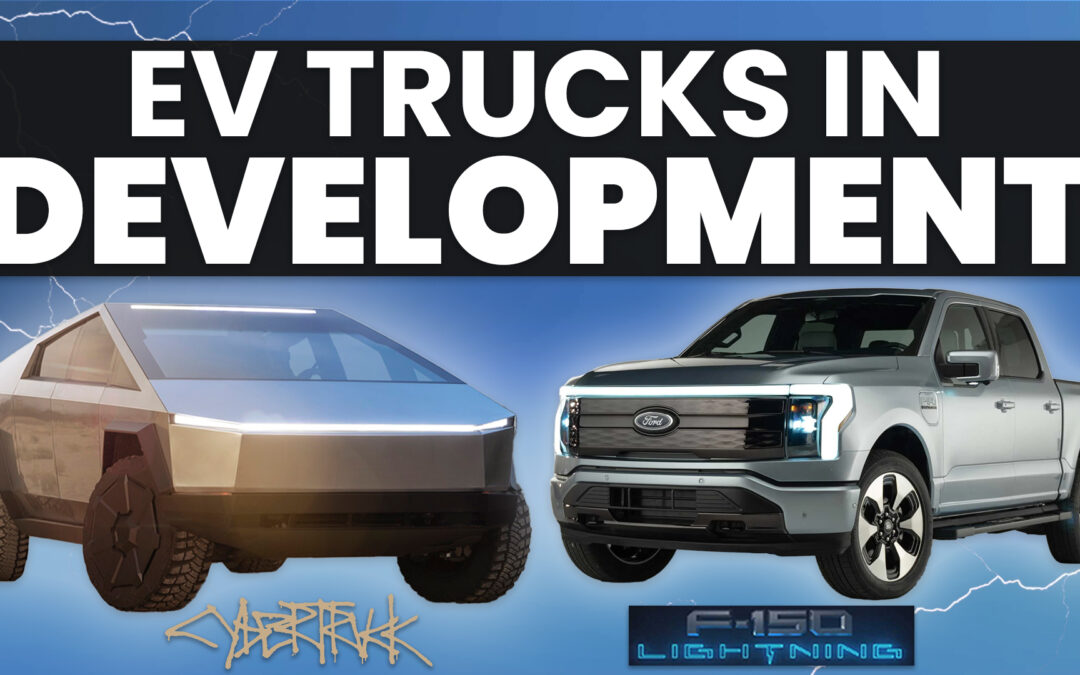
Electric trucks are few and far between on highways, but they’re all the rage online. There are fewer than 3,000 electric trucks on the road today, but at least 1.5 million reservations are in the books for upcoming electric truck models. Will trucks ever catch up to crossovers in the electrification of the auto industry? With how many models are in the development pipeline, it will be interesting to find out. Let’s take a look at every electric truck on the way, and the few you might catch a glimpse of in 2022.
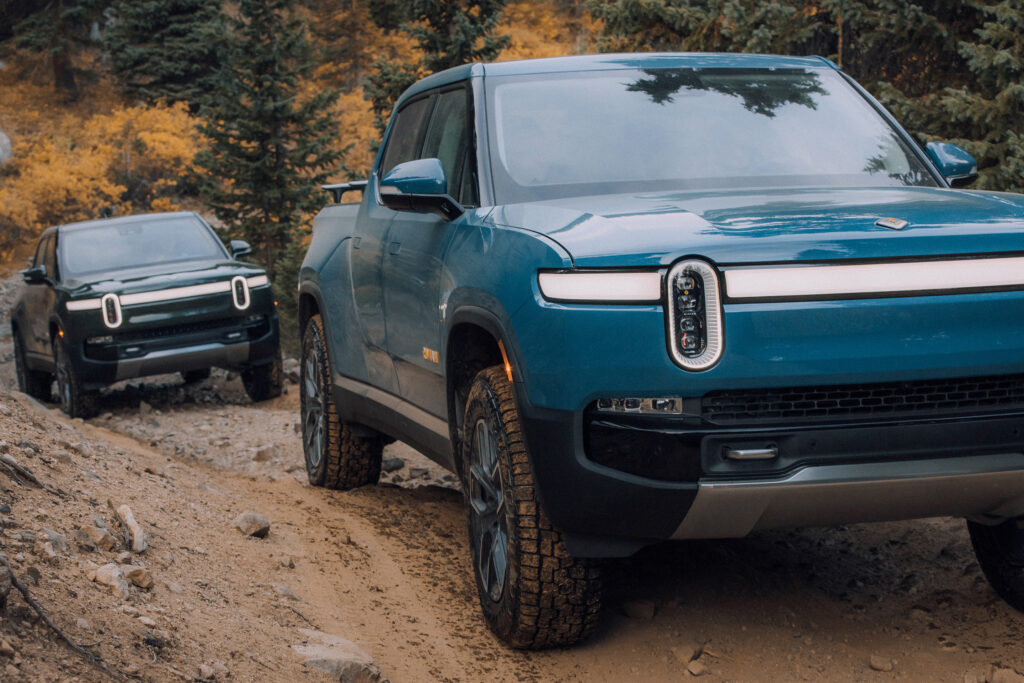
Introduced: Late 2021
Range: 314 miles
Fuel economy: 71 MPGe
Cost to charge 0 – 100% at home: $19
Price: $78,975 – $121,690
“It’s bigger than a Ford Ranger, smaller than a F-150, and a whole lot more expensive.”
The 2022 Rivian R1T is the most common electric truck on the road today, but that doesn’t mean it will be easy to find one. About 2,000 have been sold as of spring 2022. As is often the case, supply shortages (and inflation) have put a damper on the much-anticipated rollout of Rivian’s first model.
Nevertheless, it’s a very capable truck. The R1T can tow more than 11,000 pounds and the pickup offers a payload capacity of 1760 pounds. And it’s fast, with a 0-60 time of 3.3 seconds. It’s a rugged, outdoorsy-themed truck for those who use their pickup for more play than work. If you’re in the market for one, get in line. If you’re lucky (and have a deep wallet), you just might take delivery of one by the end of 2023. Rivian prices recently jumped by $10,000 – $20,000, so don’t expect a Rivian for the original price of $69,000.
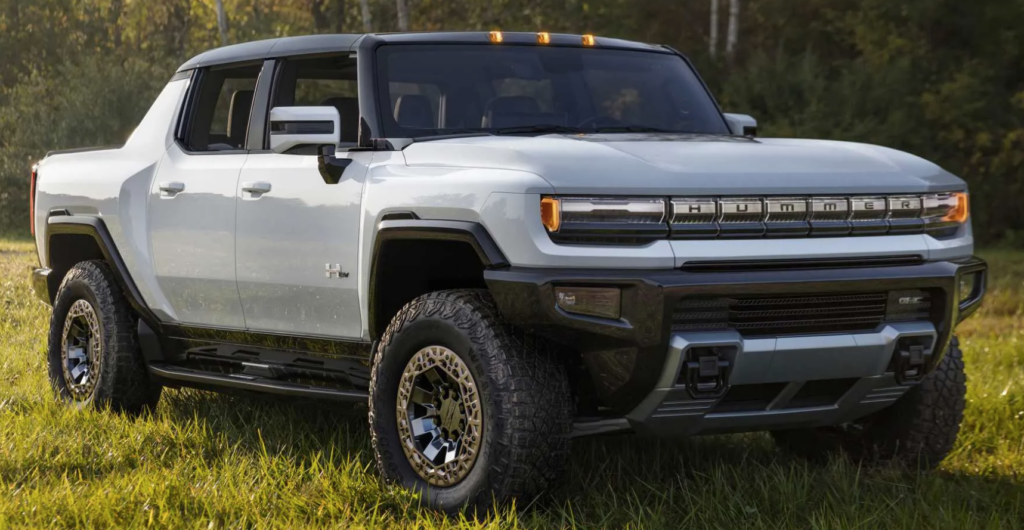
Introduced: Late 2021
Range: 329 miles
Fuel economy: 47 MPGe
Cost to charge 0 – 100% at home: $30
Price: $80,000 – $110,000+
“American excess at its finest….. and least efficient.”
If you would like a 9,000-pound, crab-walking mammoth of a truck that can seemingly overcome physics to reach 60 miles per hour in three seconds, General Motors has you covered. The revived Hummer is a large luxury truck meant to turn heads more than it’s meant to haul stuff to the worksite.
The Hummer EV’s #1 party trick is the crab-walk. That’s when the truck turns using all four weeks, allowing it to slide through traffic. The EPA-rated range of 329 miles is a bit misleading. It has a MASSIVE 212 kilowatt-hour battery. That’s triple the capacity of most electric crossovers! While technically it starts around $80,000, used ones are already selling for a quarter of a million dollars.
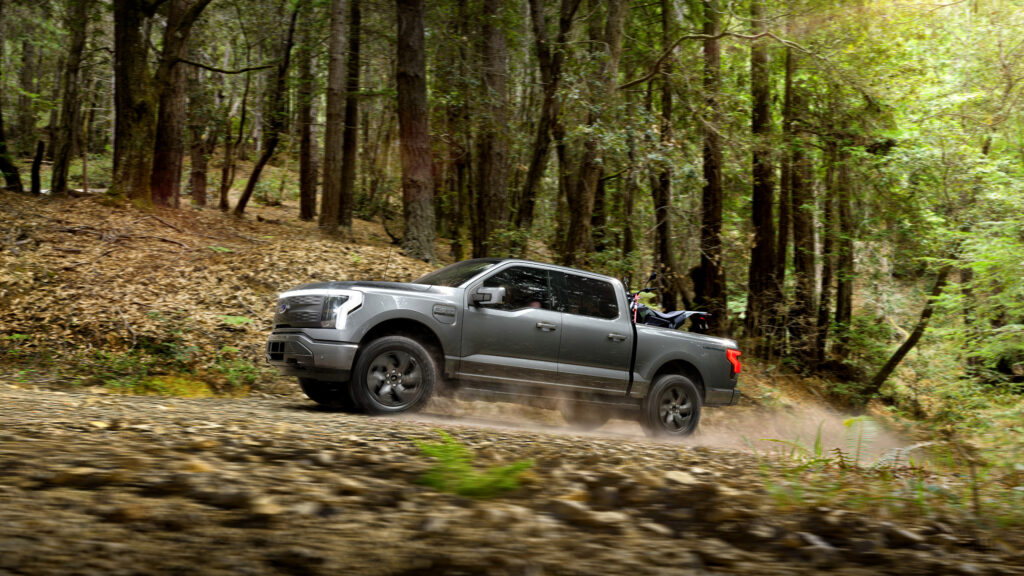
Introduced: Late 2022
Range: 230 – 300 miles
Fuel economy: 68 MPGe
Cost to charge 0 – 100% at home: $14 – $20
Price: $39,974 – $90,874
“This will be the first mass-produced electric truck on the market, but we’re bracing for the dealer markups.”
We recently detailed all we know about the upcoming electric F-150 in a special CarEdge preview. It turns out that truck fans are REALLY looking forward to the Lightning. The question remains, can Ford make enough of them?
Here’s What Stands Out With the F-150 Lightning:
Ford has 200,000 reservations in the books for the F-150 Lightning, so new orders can expect a 2024 delivery. If you’re patient, this just might be worth the wait.
Here’s everything we know about the Ford F-150 Lightning.
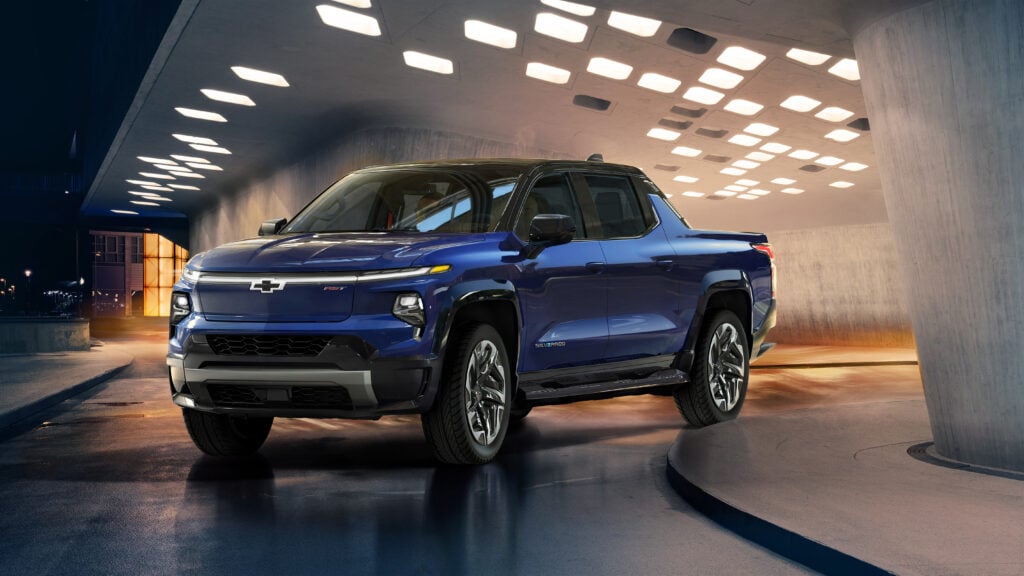
Introduced: Spring 2023
Range: Up to 400 miles (depending on battery size/trim)
Cost to charge 0 – 100% at home: $28
Price: $39,900 – $80,000+
“It’s the direct competitor to the F-150 Lightning, but it will charge a LOT faster.”
When Ford made such a big deal with the unveiling of the F-150 Lightning, we all knew General Motors would be cooking up something special. The Chevrolet Silverado EV was unveiled at last, and the specs and looks have exceeded expectations. Chevy claims it has faster charging, more power, and more range than the Ford.
It’s a flexible truck too, and one that’s definitely going to see some worksite use. The storage capacity of the 5-foot-11-inch bed can be extended to 9 feet with the ’available’ Multi-Flex Midgate.
GM says that the new Silverado is basically a rolling generator, if you buy the required accessories. “When combined with the available accessory power bar, the Silverado EV’s PowerBase charging system offers up to 10 outlets, to provide a total of 10.2kW of all-electric power for countless worksite or recreational needs, including powering your home, with the required equipment.” It can even charge other electric vehicles!
Learn more about the Chevrolet Silverado EV in our in-depth analysis.

Introduced: 2023
Range: Up to 400 miles
Price: Unavailable
“Did someone make a truck in Minecraft?!”
Ever since Tesla pulled the curtains back in November 2019, the world has divided into two camps: those who adore the Cybertruck’s angular, Mars-ready looks, and those who abhor it. No matter what your opinion is, it’s still just an idea for now. Tesla has repeatedly pushed back its arrival, and now says that 2023 will be the start of production.
The Cybertruck will have 3,500 pounds of payload capacity, and can tow 14,000 pounds. Those specs are on another level for sure. It’s also a performance-oriented truck, with a 0-60 time of 2.9 seconds. Pricing had previously been announced to start at $40,000 for rear-wheel drive base variants, but that was later removed from the Tesla website. We expect pricing to range from $55,000 to over $80,000, but it’s pure speculation at this point.

In late 2021, Toyota teased the above image of an electric truck. It closely resembles an electric Tacoma, which would be a dream come true for many Toyota fans. They haven’t said a word since, but we’ll update you with the latest once we know more.
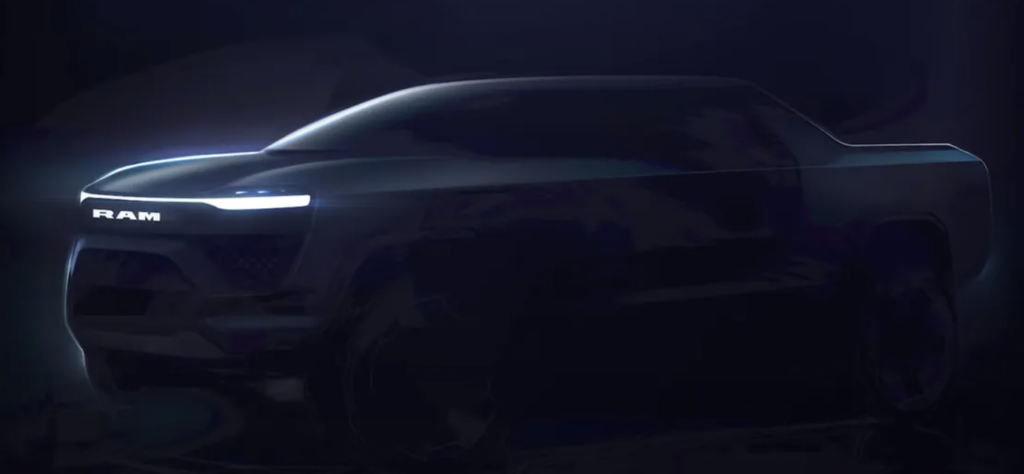
Stellantis has taken its sweet time getting into EVs. In 2024, the Ram 1500 electric truck will make a debut with a range of up to 500 miles and futuristic design cues. It will be capable of fast-charging, a quick 0-60 time, andthe latest tech from Stellantis.
The electric Ram 1500 will be built on the new STLA platform that is currently in development. More to come.
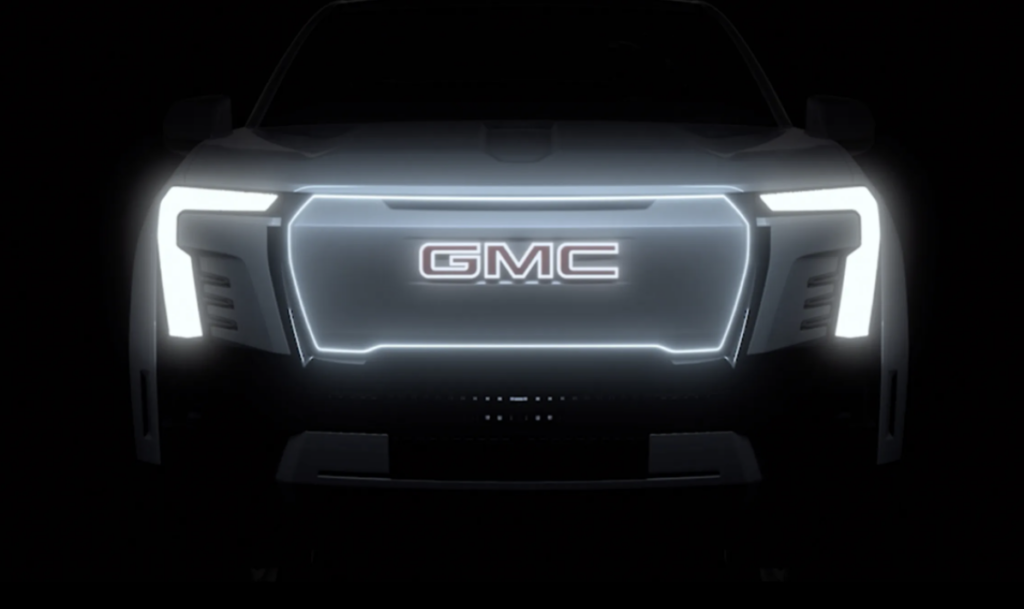
They say it’s coming, but we don’t know much yet. The electric Sierra will share the same powertrain engineering as the Silverado EV.
“Like the GMC Hummer EV, the electric Sierra will be purposefully built on the Ultium Platform with the premium materials and capability customers have come to expect from GMC trucks,” says GMC.

The Canoo ‘Pickup Truck’ has more in common with the Tesla Cybertruck that one might suspect. It’s weird-looking, has space-age ambitions, and has been repeatedly delayed. Canoo has undergone multiple leadership shakeups, and that has delayed the launch of Canoo’s first products by a few years (and counting).
The Canoo truck has a targeted payload capacity of 1,800 pounds, a 6’ 8” bed when extended, and about 500 horsepower. At least 200 miles of range are to be expected on a charge. Hopefully it turns out to be at least 250 miles considering the competition.
As odd and mysterious as the Canoo Pickup Truck is for now, the EV startup already scored a significant contract, at least symbolically. NASA selected Canoo to transport astronauts to the upcoming Artemis spaceships for missions to the moon in 2025.
With a bit of luck, the Canoo truck just might be available to reservation holders in 2023. Learn more about Canoo here.
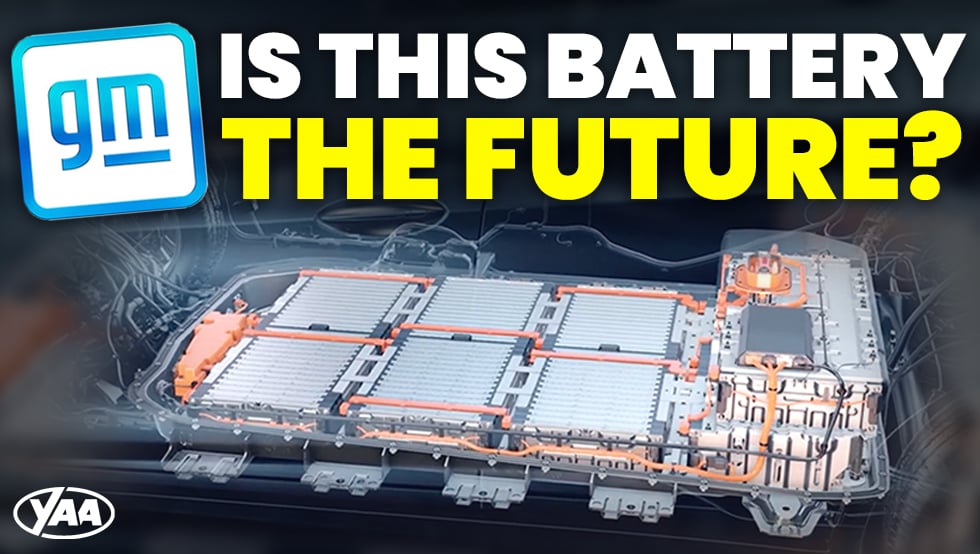
My very own Hyundai IONIQ 5 has a special trick up its sleeve. In fact, even Tesla can’t claim it. In 2022, very few electric cars are engineered with 800-volt architecture. While still an outlier, all signs point towards an auto industry heading in the direction of faster charging, better efficiency, and smaller battery sizes – all of which are unlocked by promising 800-volt electrical systems in EVs.
The mass adoption of electric vehicles largely depends on the ability to find real solutions for a few ownership challenges for today’s EV drivers:
Most electric vehicles in 2022 are built on 400-volt systems, but these systems have limits. Indeed, some automakers are quite happy with their 400-volt EV platforms. Tesla manages to find other ways of mastering efficiency and power delivery, and has not mentioned plans for a voltage upgrade. One BMW senior engineer called settling with a 400-volt platform the “best compromise”, but not everyone agrees.
800-volt systems can deliver double the power through the same current, or if desired, the same power through half the current. The result is roughly 50% faster charging for the same battery size. As a result, batteries can be made smaller and overall weight is reduced, increasing efficiency and ideally lowering the cost of the vehicle.
Would a car need a massive battery with a 500-mile range if it can charge a smaller battery that’s good for 250 miles in just 15 minutes? What is that smaller battery was A LOT cheaper?
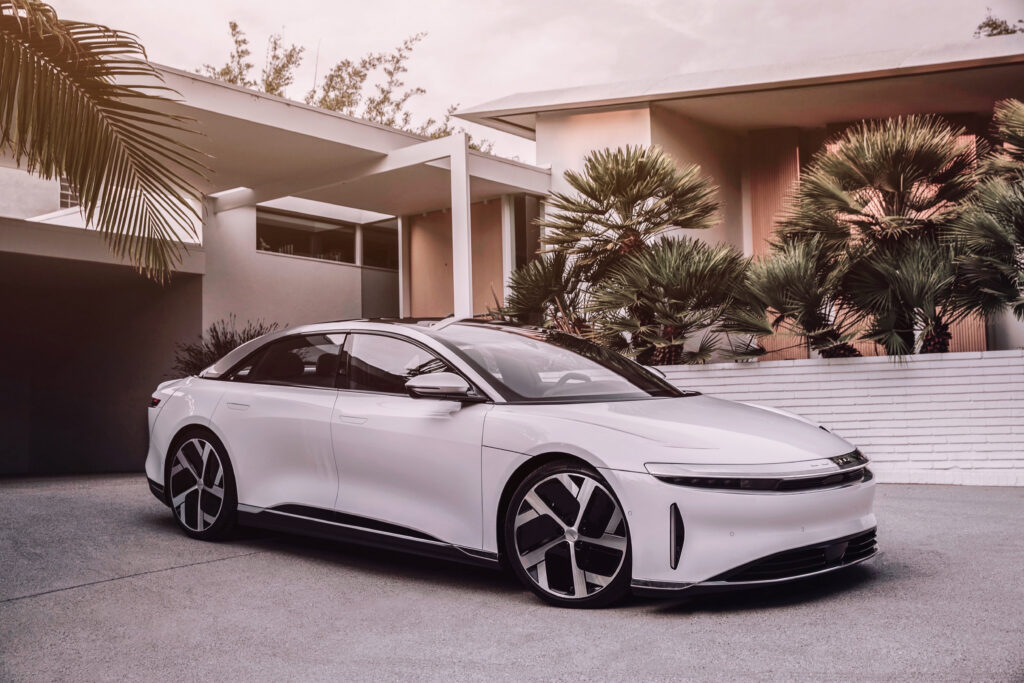
In 2022, just a few electric vehicles use 800-volt systems for power delivery and charging.
Of particular interest is the different paths taken by Ford and GM for their upcoming electric trucks. The F-150 Lightning is built on 400-volt architecture, while the Chevrolet Silverado EV is jumping to 800-volt architecture, and the result is much faster charging speeds for the Chevy. Will this matter to consumers, or will brand loyalty win out?
Why doesn’t Tesla use 800-volt charging? We’re not sure, but clearly they’ve found success with their existing 400-volt architecture.

Fortunately, a whole host of solutions are uniting to offer a better way forward for EVs. And it’s not all about charging speeds. Solid-state batteries are finally approaching real-world usability following decades of research and development. For the better part of the last decade, $100 per kilowatt-hour was the affordability target for battery development. That goal was reached, but the latest raw material shortages are sending prices back up, and electric car prices have gone up accordingly. The U.S. Department of Energy thinks that $60 per kilowatt-hour is within reach, however it’s increasingly looking like solid-state batteries may offer the only path to such low-cost batteries.
Toyota says it will be the first to bring a solid-state battery into a production vehicle. In typical Toyota fashion, their solid-state battery will debut in a hybrid powertrain rather than a full battery-electric vehicle. It looks like the world will see what solid-state battery chemistry is capable of in 2025.
Faster charging, better range, and (hopefully) lower prices are promised time and time again with every new EV model announcement. 800-volt architecture and solid-state batteries are the headlining developments that automakers are working on behind the scenes. We didn’t even touch on new battery chemistries, manufacturing methods, and electric motor breakthroughs in the works. We’ll have to save that for another day, as there’s always something new to talk about in the EV space.
But the promise of faster charging and energy-dense batteries begs the question: would you take faster charging over more range? It’s looking like that will be the EV debate of the decade. What are your thoughts? Let us know in a comment or over at the CarEdge Community Forum. What matters most when you head out on a journey?
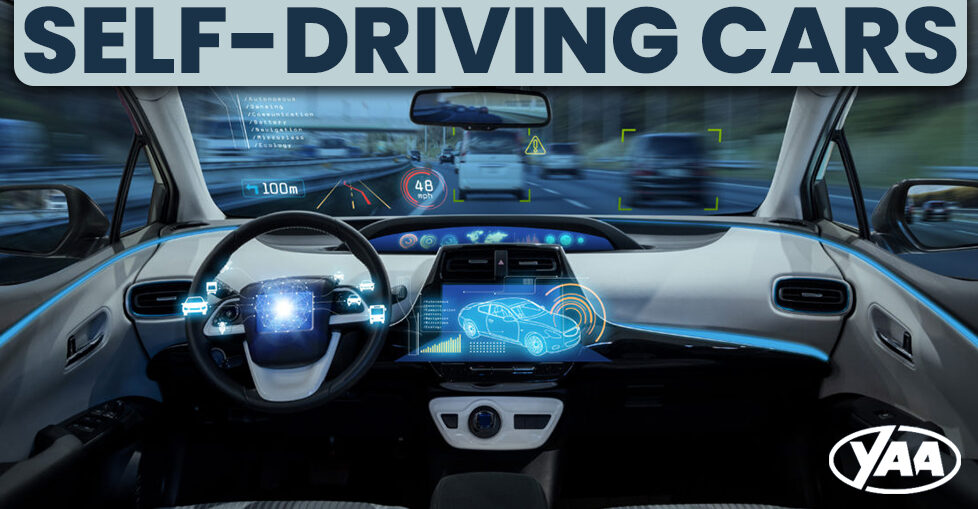

Have you ever seen a driverless vehicle? Not a Tesla, but a moving car, truck or SUV without anyone in the driver’s seat? True self-driving cars are less than a decade away, and key players have established a new industry that’s on the verge of spilling out into the mainstream. Legacy automakers are investing billions of dollars into emerging AI startups focused on driverless tech. These are the big names in autonomous driving, and the automakers they’re teaming up with.
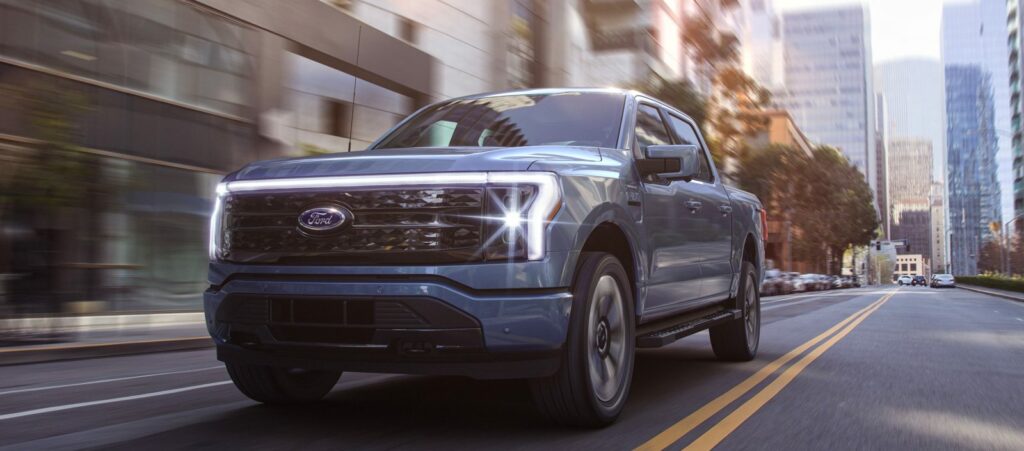
Argo is a Pittsburgh based tech company that is making a name for itself as a leader of autonomous driving technology that is relatively close to mass adoption. Argo has partnerships with Ford, Volkswagen, Walmart and Lyft. The Argo Self-Driving System is already undergoing testing with Ford and Volkswagen vehicles.
Argo’s weakness is more likely a tradeoff that engineers at Argo were willing to accept in exchange for higher probability of success in the near future. And it seems to be working well for them. Argo Self-Driving works on roadways that are intricately mapped beforehand so that the system knows about street-level conditions and safety precautions.
In conjunction with an all-of-the-above sensor approach (LiDAR, radar and cameras), Argo Self-Driving is designed to drive like an experienced driver, but only in certain areas. The benefit of this approach is that it’s much more realistic in the near-term, despite its limited use case.
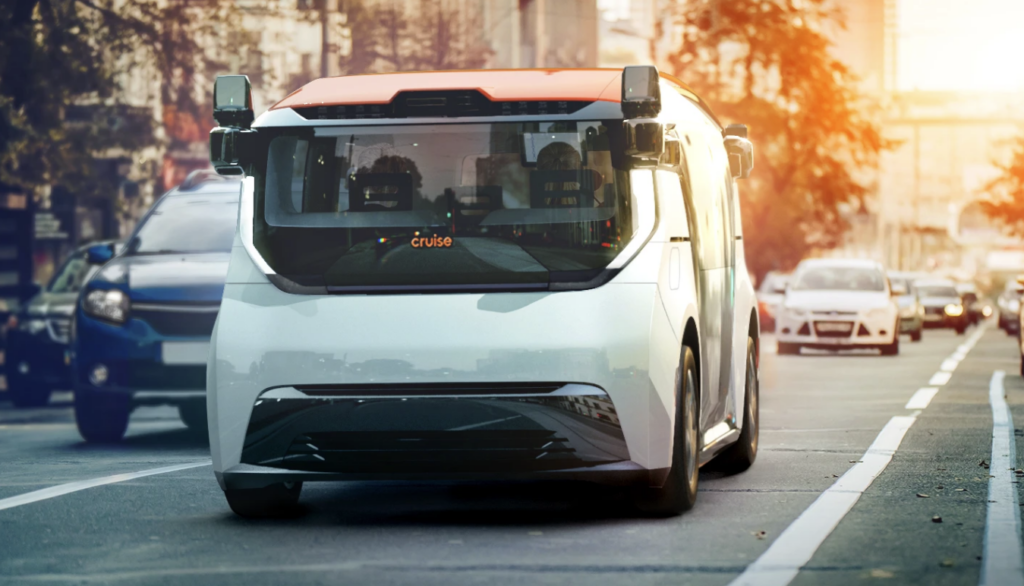
The first generation Cruise Autonomous Vehicle exists on a modified version of the Chevrolet Bolt. That’s because General Motors bought the Cruise startup back in 2016. Rest assured that the next milestone for this promising company is the launch of the Cruise Origin, a driverless pod without a steering wheel. In January of 2021, Honda announced a partnership with Cruise to bring the Origin to Japan. GM announced that the Cruise will begin production in Detroit in 2023. Cruise will certainly be competing head-to-head with Zoox and others with eerily similar product roadmaps.
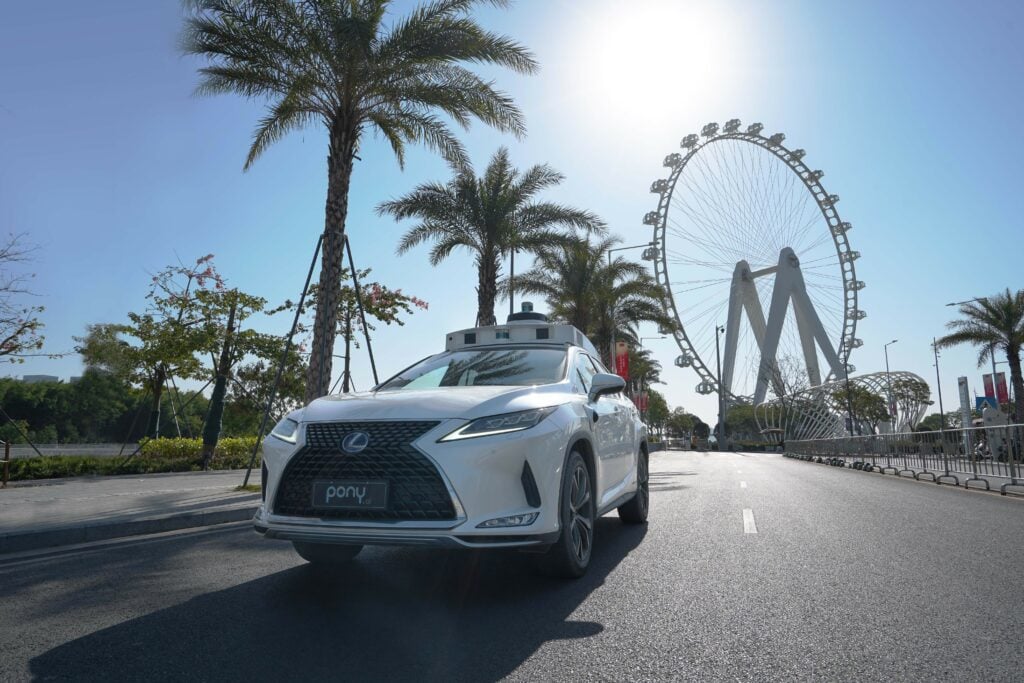
With millions of kilometers of testing completed and a data-driven approach, Pony.AI is playing the long game in autonomous driving. That’s not stopping them from getting off to a strong start. Pony.ai was the first to launch a robo taxi service in 2018, allowing passengers to hail self-driving cars in Guangzhou, Beijing, Irvine, CA, and Fremont, CA. In February 2020, Toyota invested $400 million in the company.
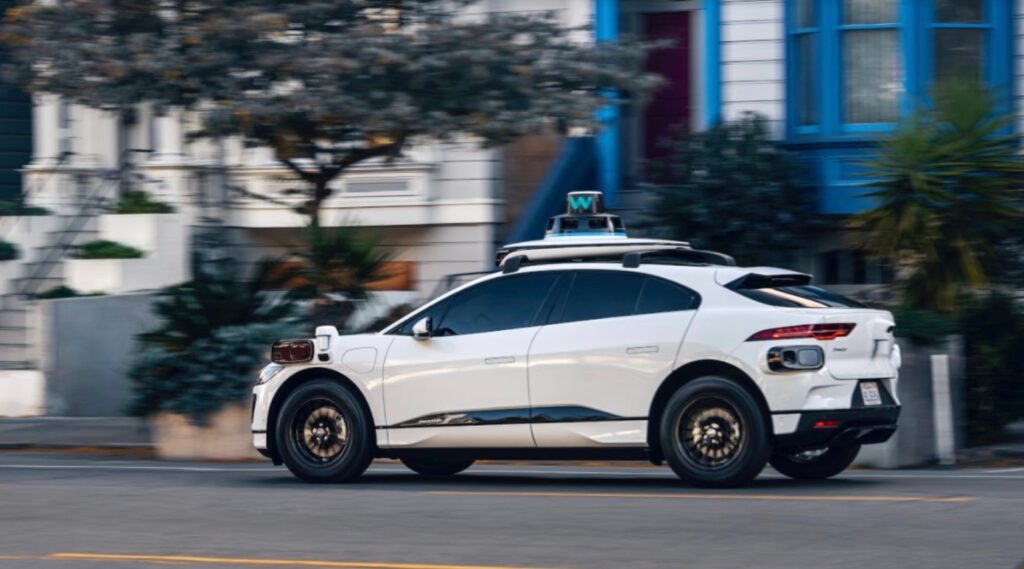
Formerly the Google Self-Driving car project, Waymo is off to a great start with their sensor-loaded approach to autonomous driving. Google started their self-driving research in 2009 back when optimism about near-future autonomy was peaking. Now, Waymo continues as a subsidiary of Alphabet, Google’s parent company.
In 2022, Waymo currently operates ride-hailing driverless vehicles in the Phoenix area, and testing has started in San Francisco and New York. Waymo equips vehicles with a suite of sensors that help the autonomous system paint a picture of the environment around the car at all times. It’s not perfect, but riders say it’s impressive and improving. Interestingly, not all of the vehicles equipped with autonomous driving are fully-electric. Driverless Chrysler vans are a common sight in Phoenix.

Zoox, a recent subsidiary of Amazon, has the goal of providing enjoyable mobility-as-a-service in dense urban environments. Basically, autonomous ride-hailing. Zoox handles the driving, charging, maintenance, and upgrades for their vehicles. It’s like an autonomous taxi, sort of like Waymo. The rider will simply pay for the service. The Zoox vehicle is a passenger-focused capsule designed in-house. We’ll be hearing more about Zoox autonomous vehicles.
The global autonomous vehicle market was valued at $76.13 billion in 2020, and is projected to reach $2 trillion by 2030. Legacy automakers like GM, Ford, Stellantis and Volkswagen are banking on partnerships with AI startups to leapfrog into a future where driverless vehicles are safe, affordable and accessible. How will the likes of Tesla, Lucid, Rivian, and other newcomers innovate and adapt to the changes to come? Time will tell.
Want to know more? Here’s every automaker’s plan for autonomous driving investments.
Buying a Car? Share Your Experience With Others
Getting ready to buy? See how dealers near you have been treating customers at CarEdge Dealer Reviews. When you make a vehicle purchase, don’t forget to share your experience with the CarEdge family. All submissions are vetted by the CarEdge team. Together, we can transform the car buying experience.


Trucks are somehow an appreciating asset in 2022. Not a single truck is getting more affordable. With inflation, supply shortages, and transportation backlogs, truck inventory remains at record lows in the US. Here’s just how much truck prices have increased in 2022.
Be sure to bookmark this page and check back for updates!
The 2022 model year Chevrolet Silverado HD has seen FOUR price increases since going on sale last year. GM Authority details the latest Silverado price increases:
“The latest price increase for the 2022 Chevy Silverado HD is a flat $1,000 for all trim levels and configurations, including both the 2022 Chevy Silverado 2500HD, and the 2022 Chevy Silverado 3500HD. The Destination Freight Charge also increased from $1,695 to $1,795. As it stands now, the least-expensive 2022 Chevy Silverado HD model is the Silverado 2500HD WT Regular Cab / Long Bed with 2WD and the 6.6L V8 L8T gasoline engine, priced at $41,295, while the most-expensive model is the Silverado 3500HD High Country Crew Cab / Long Bed DRW with 4WD and the 6.6LV8 L5P turbodiesel Duramax engine, priced at $81,345.”
See how much every variant of the Silverado 2500 and 3500 HD costs now here.
Just a few months after the first deliveries crawled out of Rivian’s factory in Normal, Illinois, the electric truck maker fumbled a sudden price increase. All trims of the Rivian R1T saw prices increase, and some specs are up by 20%. The most ‘affordable’ R1T, originally $67,500, now costs $79,500. The catch is that the base spec of the R1T is not even close to being available. Rivian produced 2,500 electric trucks in the first quarter of the year, and delivered 1,200 of them.

All R1Ts being delivered in 2022 are the quad-motor Adventure package with the large battery pack. If you’re lucky enough to take delivery this year, this R1T configuration costs $85,000.
This is Rivian’s delivery timeline as of Spring 2022:
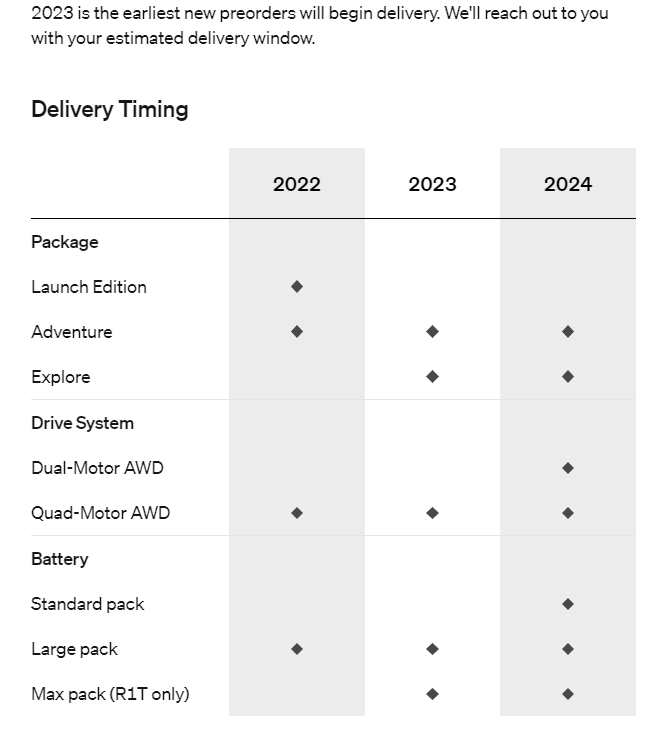

Is there any such thing as an affordable truck any more? Affordability is in the eye of the beholder, however the last few months have raised the bar even further. Here’s the latest data on truck MSRPs for base trims:
The best-selling truck in America, the Ford F-150, has seen a 2.6% increase in base MSRP since December 2021. The F-150 now starts at $29,990. The only truck to fare better (for the consumer) is the Toyota Tacoma, which has gone up 2.1% to a current MSRP of $26,700.
On the other end of the spectrum, General Motors has sent truck prices through the roof. Four months ago, a 2021 Silverado 1500 started at $29,300. A few price hikes later, the base 2022 Silverado now costs $33,800 before destination fees. That’s a staggering 15% price jump in a few short months.
GM’s massive price increases for the 2022 Silverado are especially shocking considering that GM posted record profits in 2021, despite selling 500,000 fewer vehicles than the year before.
The 2022 Nissan Titan now has a base MSRP of $38,310, up 4.8% since late last year. The Ram 1500 has seen a similar price hike, now listing for $33,975 at a minimum. Good luck finding one for MSRP.
In fact, let us know about your dealership experience, good or bad!
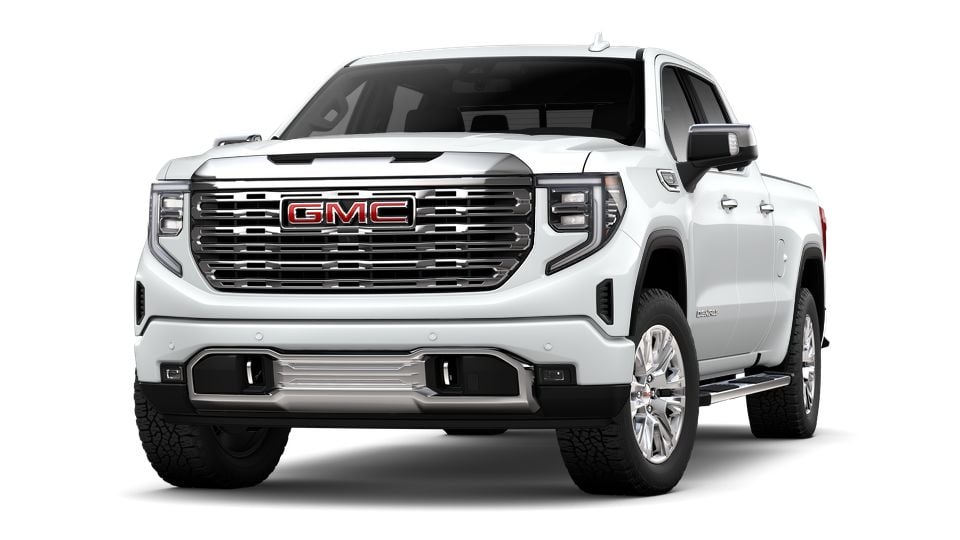
If you thought the base models were bad, wait until you see how expensive fully-loaded trucks have gotten. Check out the data for yourself:
Yes, a 2022 Ford F-150 Raptor now starts at $68,675 (over $70,000 after taxes and fees) after Ford bumped the price by 7% this year. That almost makes the F-150 Lariat look like a steal at $48,140. It’s actually Ram that takes the trophy for biggest MSRP jump in 2022. Following a 9.1% price increase, the Ram 1500 TRX now starts at $76,780. The GMC Sierra AT4X has seen the smallest price increase, but it’s still an expensive truck at an MSRP $77,395.
The short answer is no. If you’re looking to buy new, you’ll have to find a Ford Maverick, Ford Ranger, Hyundai Santa Cruz or maybe even a Tacoma at MSRP (somehow) to stay around $25,000 for a new truck. Most are far beyond $35,000 once all fees are tallied.
Bear in mind that we’re talking about MSRPs here. These are merely suggestions by the manufacturer. You know as well as I do that buying any popular vehicle at sticker price in 2022 is like finding a pot of gold at the end of the rainbow. It’s technically possible, but quite rare. And no one will believe you.
Dealer markups are one of the many novel trends of the past few pandemic years that no one’s excited about. Except for dealers of course. Jalopnik reported on six-figure Ram TRXs and Ford Mavericks going for fifty grand.
Dealers are raking in the profits every time a shopper agrees to pay over MSRP for any truck. Don’t believe me? American dealerships reported all-time record profits in 2021. You know, the year with the worst inventory shortages ever. As one dealer told me, they’re just ‘dying for inventory’. Approach dealerships with caution, truck buyers.
CarEdge Car Search Now Shows In-Transit Status!
In 2022 (and beyond), many car buyers will be shopping for vehicles that are still sailing the high seas or catching a lift from the plant to the dealership. How do you know which vehicles are in transit and which are on the lot? CarEdge’s Car Search is the only car buying search engine that shows you if a particular vehicle is in transit. Try it out for yourself!